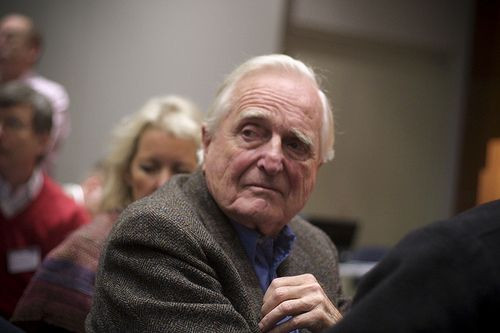Doug Engelbart, Inventor Of The Computer Mouse And Key Player In Developing Framework For Internet, Dies At 88

After an e-mail sent by his daughter to California's Computer History Museum Wednesday morning, the news was announced of Doug Engelbart's death. The inventor of the computer mouse and the holder of more than twenty patents was 88 years old.
Engelbart's daughter, Christina, told the Museum in an e-mail of her father's passing after he died peacefully in his sleep Tuesday night. He had been in poor health, she said of her father, who is credited with inventing the first device that allows a user to control a cursor on-screen. The demonstration of the first mouse, which took place in San Francisco in 1968, has been called "the mother of all demos."
Engelbart's invention eventually became known as "the mouse" because of the tail-like cord that stuck out one end. Engelbart once said in an interview, however, that the originator of the name has been lost over time.
"I wasn't the kind of person that made up the names for what we were going to call it — just, 'gadget,' he said. "Nobody could remember among all the people who were involved in that who first started calling it a mouse. That name just stuck."
While the mouse first debuted in 1968, it wasn't commercially available until 1984, after the Stanford Research Institute — where Engelbart worked at the time — licensed the technology to Apple for $40,000.
And despite its innovation, the mouse was not particularly lucrative for Engelbart, as the invention's patent ran out before the world had a great demand for it. Early incarnations of the design featured a wooden shell covering two simple wheels.
He also imagined a similar device that attached on a desk's underside and was controlled by the user's knee.
The son of a housewife and radio repairman, Engelbart grew up in Oregon and attended college at Oregon State University where he studied electrical engineering. He worked briefly as a radar technician during World War II and eventually received his Ph.D. from the University of California Berkeley.
His interest in how computers could be used to aid human cognition eventually led him to Stanford Research Institute (SRI) and then his own laboratory, the Augmentation Research Center, according to the BBC.
At his own lab, he helped develop ARPANet, a framework that would eventually evolve into the Internet as we know it today. Among his other forward-thinking designs were videoconferencing, hypertext, and shared screen collaboration.
The humble engineer and scientist often downplayed his role in such inventions, crediting himself as more of a visionary than an implementer.
"Many of those firsts came right out of the staff's innovations — even had to be explained to me before I could understand them," his daughter quoted in a biography. "They deserve more recognition."
Through this passion for collaboration, he eventually formed his ideas of "Collective IQ," the inspirations for which eventually turned into a blog run by him and his daughter. The motivation behind Collective IQ was intended to be "a measure of how effective people are at addressing complex, urgent challenges collectively."
Always ahead of his time, the Computer History Museum offered a quote from the late innovator.
"The better we get at getting better," he said, "the faster we will get better."
Engelbart is survived by his second wife, Karen O'Leary Engelbart, and his four children.
Published by Medicaldaily.com



























